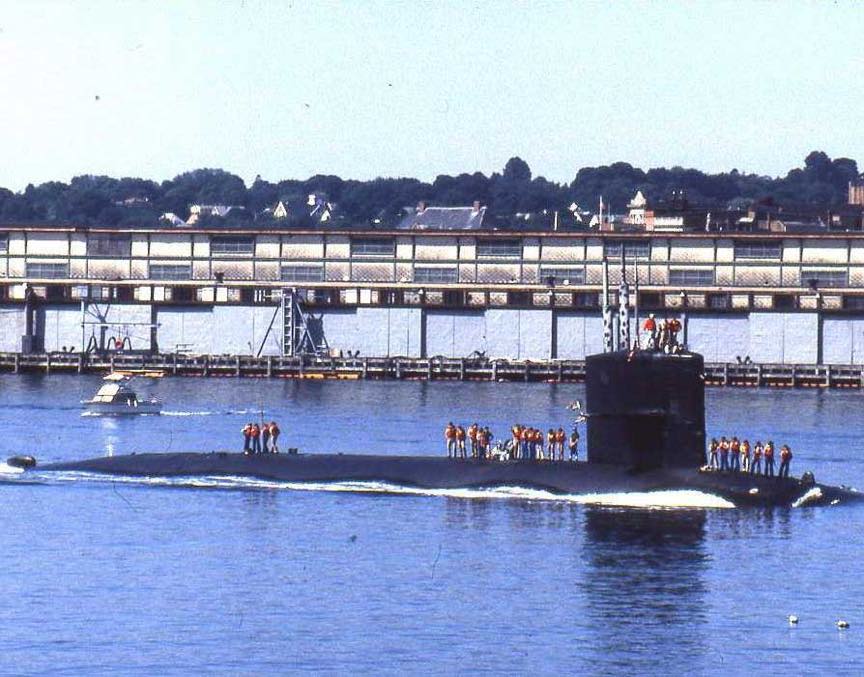
Whale II
(SSN-638: dp. 3,860 (surf.), 4,640 (subm.), 1. 292'3" b. 31'8"; dr. 29'; s. 15+ k. (surf.), 20+ k. (subm.) epl. 107; a. 4 21" tt., SUBROC; el. Sturgeon)
The second Whale (SSN-638)—a nuclear-powered attack submarine—was laid down on 27 May 1964 at Quincy, Mass., by the General Dynamics Corp., Quincy Division; launched on 14 October 1966; sponsored by Mrs. Russell B. Long, and commissioned on 12 October 1968, Comdr. William M. Wolff in command.
Whale arrived in her first home port, Charleston, on 2 November and, after a week in port, put to sea for shakedown training which the nuclear attack submarine completed in November and December, along with a series of post-commissioning tests, trials, and qualifications. In January 1969, she began normal operations out of Charleston with type training along the southeastern coast of the United States.
On 18 March, she stood out of Charleston on her way to operations north to the Arctic Circle. She reached the North Pole on 6 April and surfaced there in commemoration of the 60th anniversary of Rear Admiral Robert E. Peary's arrival there. Following that event, she completed her mission under the polar ice cap and then headed south. After a visit to Faslane, Scotland, she voyaged home to Charleston, where she arrived on 9 May.
Following two months of local operations out of Charleston' Whale sailed for Groton, Conn., and her post-shakedown repair period. After three months in the Electric Boat Division's yard, she started back to Charleston on 16 October. She arrived back in her home port on the 20th and conducted local operations for the remainder of the year.
During the first half of 1970, Whale continued operations out of Charleston. In late January, she participated in tests with a Navy Underwater Demolition Team and, in February and March, took part in three major Fleet exercises. In April, she headed north for a brief tour of duty as training ship for the Prospective Commanding officers' School at New London Conn. She returned to Charleston at the end of the first week in May and spent the remainder of the month conducting acoustic trials.
Whale departed Charleston on 27 July for an overseas deployment which she concluded in mid-September with visits to Faslane and Holy Loch in Scotland. While Whale visited Scotland, the Jordanian crisis—precipitated by civil war between the Jordanian Government and the Palestinian Liberation Organization (PLO) and aggravated by the incursion into northern Jordan by Syrian tanks—necessitated a show of American strength in the eastern Mediterranean. Thus, Whale received orders to join the 6th Fleet and did so near the end of September. She remained in the Mediterranean through October and into November. When the crisis abated, she headed for Charleston, arriving home on 18 November.
Three Fleet exercises and local operations out of Charleston occupied the submarine during the first half of 1971. Late in July, she deployed once more for special operations in the Atlantic, concluding that cruise late in September at Bremerhaven, Germany. She returned to Charleston on 12 October and resumed local operations upon arrival. That routine continued until 20 March 1972, when she departed once again for another special operations cruise in the Atlantic. At the end of that voyage, Whale made a brief call at Holy Loch before returning to Charleston on 9 June.
Almost two months after her return to the United States, Whale left Charleston and headed north to Groton, Conn., her new home port. She entered the yard at the Electric Boat Division on 7 August for a 46 week overhaul and remained there undergoing repairs until 27 October 1973.
She completed post-overhaul shakedown and refresher training in November and December and began preparations for another deployment to the Mediterranean in response to the Middle Eastern crisis brought about by the Arab Israeli War in October 1973. Late in January 1974, however, she received notification that her deployment had been delayed until May. During the interim, she conducted normal operations out of Groton —including submarine ASW exercises, type training, and a major fleet exercise, Operation "Safe Passage." On 3 May, she departed Groton en route to the Mediterranean Sea. Nine days later, she changed operational control from 2d Fleet to 6th Fleet.
While in the Mediterranean, Whale participated in two NATO exercises, "International Week" and "Dale Falcon," with units of the Greek and Italian navies as well as several ASW exercises with other units of the 6th Fleet. She passed through the Strait of Gibraltar and changed operational control back to the Commander, Submarines, Atlantic Fleet, on 18 October. During the voyage home, Whale participated in a Fleet ASW exercise which she completed on 28 October, two days before she reentered Groton.
Whale spent the next 11 months engaged in operations out of Groton. Various tests and evaluations occupied January and the first half of February 1975. Between then and June, the submarine provided training services for various units of the Atlantic Fleet and for prospective commanding officers. Whale also served as a training platform for midshipmen during indoctrination cruises held late in the summer. On 29 September, she stood out of Groton for another deployment with the 6th Fleet. During that cruise, she took part in a major 2d Fleet exercise, "Ocean Safari," and, after joining the 6th Fleet in the Mediterranean Sea, took part in a succession of unilateral, bilateral, and multilateral exercises with units of the navies of Greece, France, Italy, and the Netherlands. She completed her tour of duty with the 6th Fleet during the second week in March 1976 and arrived back in Groton on the 26th.
She resumed normal east coast operations until 9 September when she entered the Portsmouth (N.H.) Naval Shipyard for a refueling overhaul. That overhaul concluded on 7 July 1978. Whale then spent the remainder of the year in refresher training for the purpose of obtaining certification throughout the full range of her weapons system.
